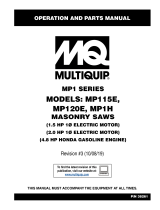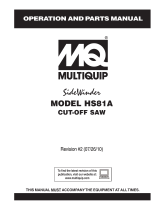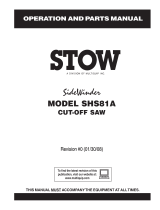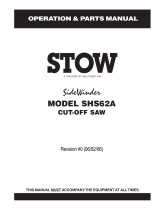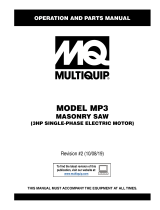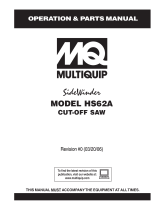Page is loading ...

OPERATION AND PARTS MANUAL
P/N 25939
THIS MANUAL MUST ACCOMPANY THE EQUIPMENT AT ALL TIMES.
To find the latest revision of this
publication, visit our website at:
www.multiquip.com
MP1 SERIES
MODELS
MP1455H (5.5 HP GASOLINE)
MP1415E (1.5 HP ELECTRIC)
MP1420E (2.0 HP ELECTRIC)
MASONRY SAWS
Revision #3 (03/29/10)

PAGE 2 — MP1 — OPERATION AND PARTS MANUAL — REV. #3 (03/29/10)
Engine exhaust and some of
its constituents, and some dust created
of California to cause cancer, birth
defects and other reproductive harm.
by power sanding, sawing, grinding,
drillingandotherconstructionactivities
contains chemicals known to the State
Some examples of these chemicals are:
Leadfromlead-basedpaints.
Crystallinesilicafrombricks.
Cementandothermasonryproducts.
Arsenicandchromiumfromchemically
treatedlumber.
Your risk from these exposures varies,
dependingonhowoftenyoudothistype
of work. To reduce your exposure to
these chemicals: work in aALWAYS
well ventilated area, and work with
approved safety equipment, such as
dust masks that are specially designed
to filter out microscopic particles.
PROPOSITION 65 WARNING

MP1 — OPERATION AND PARTS MANUAL — REV. #3 (03/29/10) — PAGE 3
Grinding/cutting/drilling of masonry, concrete, metal and
other materials with silica in their composition may give
off dust or mists containing crystalline silica. Silica is a
basic component of sand, quartz, brick clay, granite and
numerous other minerals and rocks. Repeated and/or
substantial inhalation of airborne crystalline silica can
cause serious or fatal respiratory diseases, including
silicosis. In addition, California and some other
authorities have listed respirable crystalline silica as a
substance known to cause cancer. When cutting such
materials, always follow the respiratory precautions
mentioned above.
WARNING
Grinding/cutting/drilling of masonry, concrete, metal and
other materials can generate dust, mists and fumes
containing chemicals known to cause serious or fatal
injury or illness, such as respiratory disease, cancer,
birth defects or other reproductive harm. If you are
unfamiliar with the risks associated with the particular
process and/or material being cut or the composition of
the tool being used, review the material safety data
sheet and/or consult your employer, the material
manufacturer/supplier, governmental agencies such as
OSHA and NIOSH and other sources on hazardous
materials. California and some other authorities, for
instance, have published lists of substances known to
cause cancer, reproductive toxicity, or other harmful
effects.
Control dust, mist and fumes at the source where
possible. In this regard use good work practices and
follow the recommendations of the manufacturers or
suppliers, OSHA/NIOSH, and occupational and trade
associations. Water should be used for dust
suppression when wet cutting is feasible. When the
hazards from inhalation of dust, mists and fumes cannot
be eliminated, the operator and any bystanders should
always wear a respirator approved by NIOSH/MSHA for
the materials being used.
WARNING
SILICOSIS WARNING RESPIRATORY HAZARDS
SILICOSIS/RESPIRATORY WARNINGS

PAGE 4 — MP1 — OPERATION AND PARTS MANUAL — REV. #3 (03/29/10)
TABLE OF CONTENTS
MP1 MASONRY SAW
Proposition 65 Warning ............................................. 2
Silicosis/Respiratory Warnings .................................. 3
Table Of Contents ..................................................... 4
Parts Ordering Procedures ....................................... 5
Safety Message Alert Symbols .............................. 6-7
Rules For Safe Operation .................................... 8-10
Operation and Safety Decals .................................. 11
Specifications .......................................................... 12
Dimensions ............................................................. 13
General Information ................................................ 14
Controls and Components ................................. 16-17
Electric Motor Components .................................... 18
Engine Components ............................................... 19
Pre-Setup (Electric) ............................................ 20-23
Pre-Setup (Gasoline) ......................................... 24-25
Operation (Electric) ............................................ 26-27
Operation (Electric) ............................................ 28-29
Maintenance ...................................................... 30-33
Electric Motor Wiring Diagram ................................ 34
Troubleshooting (Blade) .......................................... 36
Troubleshooting (Electric Motor) ............................. 37
Troubleshooting (Gasoline Engine) ................... 38-39
Explanation of Code In Remarks Column............... 40
Suggested Spare Parts ........................................... 41
MP1 COMPONENT
DRAWINGS
HONDA GX160K1QXC9
GASOLINE ENGINE
NOTE

MP1 — OPERATION AND PARTS MANUAL — REV. #3 (03/29/10) — PAGE 5
PARTS ORDERING PROCEDURES
www.multiquip.com
Ordering parts has never been easier!
Choose from three easy options:
WE ACCEPT ALL MAJOR CREDIT CARDS!
When ordering parts, please supply:
R Dealer Account Number
R Dealer Name and Address
R Shipping Address (if different than billing address)
R Return Fax Number
R Applicable Model Number
R Quantity, Part Number and Description of Each Part
R Specify Preferred Method of Shipment:
UPS/Fed Ex DHL
N Priority One Tr u c k
N Ground
N Next Day
N Second/Third Day
If you have an MQ Account, to obtain a Username
and Password, E-mail us at: parts@multiquip.
com.
To obtain an MQ Account, contact you
r
District Sales Manager for more information.
Order via Internet (Dealers Only):
Order parts on-line using Multiquip’s SmartEquip website!
N View Parts Diagrams
N Order Parts
N Print Specification Information
Note: Discounts Are Subject To Change
Goto www.multiquip.com and click on
Order Parts
to log in and save!
Use the internet and qualify for a 5% Discount
on Standard orders for all orders which include
complete part numbers.*
Order via Fax (Dealers Only):
All customers are welcome to order parts via Fax.
Domestic (US) Customers dial:
1-800-6-PARTS-7 (800-672-7877)
Fax your order in and qualify for a 2% Discount
on Standard orders for all orders which include
complete part numbers.*
Order via Phone:
Domestic (US) Dealers Call:
1-800-427-1244
Best Deal!
International Customers should contact
their local Multiquip Representatives for
Parts Ordering information.
Non-Dealer Customers:
Contact your local Multiquip Dealer for
parts or call 800-427-1244 for help in
locating a dealer near you.
Note: Discounts Are Subject To Change
Effective:
January 1
st
, 2006
NOTICE
All orders are treated as Standard Orders and will
ship the same day if received prior to 3PM PST.

PAGE 6 — MP1 — OPERATION AND PARTS MANUAL — REV. #3 (03/29/10)
Safety precautions should be followed at all times when operating
this equipment. Failure to read and understand the Safety
Messages and Operating Instructions could result in injury to
yourself and others.
FOR YOUR SAFETY AND THE SAFETY OF OTHERS!
This Owner's Manual has been
developed to provide complete
instructions for the safe and
efficient operation of the
MULTIQUIP MP1
Before using this MASONRY SAW, ensure that the operating
individual has read and understands all instructions in this
manual.
SAFETY MESSAGE ALERT SYMBOLS
DANGER
WARNING CAUTION
DANGER: WILL KILLED
DO NOT
WARNING: CAN KILLED
DO NOT
CAUTION: CAN
DO NOT
HAZARD SYMBOLS
Hazard Symbols
Message Alert Symbols
Burn Hazards
DO NOT
NEVER
Rotating Parts
NEVER
hands hair
clothing
Guards and Covers In Place
NEVER
Rotating Blade
Accidental Starting
ALWAYS ON/OFF
OFF
NOTE
SAFETY MESSAGE ALERT SYMBOLS

MP1 — OPERATION AND PARTS MANUAL — REV. #3 (03/29/10) — PAGE 7
Over Speed Conditions
NEVER
Respiratory Hazard
ALWAYS
ALWAYS
Sight and Hearing hazard
Equipment Damage Messages
NEVER
DO
NOT
DO NOT
DO NOT
NEVER
Explosive Fuel
Lethal Exhaust Gases
HAZARD SYMBOLS - Gasoline Powered Models
This
saw
, other property, or the
surrounding environment could be
damaged if you do not follow
instructions.
NOTE
SAFETY MESSAGE ALERT SYMBOLS

PAGE 8 — MP1 — OPERATION AND PARTS MANUAL — REV. #3 (03/29/10)
RULES FOR SAFE OPERATION
CAUTION:
Failure to follow instructions in this manual may
lead to serious injury or even death! This
equipment is to be operated by trained and
qualified personnel only! This equipment is
for industrial use only.
The following safety guidelines should always be used when
operating the MP1 SAW. Unless otherwise noted, these
guidelines refer to saws with gasoline powered engines.
SAFETY
■
DO NOT operate or service this equipment
before reading this entire manual.
■
This equipment should not be operated by
persons under 18 years of age.
■
NEVER operate the saw without proper protective
clothing, shatterproof glasses, steel-toed boots
and other protective devices required by the job.
■
NEVER operate this equipment when not
feeling well due to fatigue, illness or taking
medicine.
■
NEVER operate the saw under the
influence or drugs or alcohol.
■
NEVER use accessories or attachments,
which are not recommended by Multiquip
for this equipment. Damage to the equipment and/or injury to
user may result.
■
Manufacturer does not assume responsibility for any accident
due to equipment modifications. Unauthorized equipment
modification will void all warranties.
■
Whenever necessary, replace nameplate, operation and
safety decals when they become difficult read.
■
ALWAYS check the saw for loosened threads or bolts before
starting.
■
NEVER operate the saw in an explosive atmosphere where
fumes are present or near combustible materials. An explosion
or fire could result causing severe
bodily harm or even
death.
■
NEVER use fuel as a cleaning agent.
■
ALWAYS use extreme caution when
working with flammable liquids. When
refueling, stop the engine and allow it to cool.
■
NEVER
smoke
around or near the
machine. Fire or explosion could result from
fuel vapors
, or if fuel is spilled on a
hot!
engine.
■
Topping-off to filler port is dangerous, as it tends to spill fuel.
■
ALWAYS service air cleaner frequently to prevent carburetor
malfunction.
■
NEVER run the engine without the air filter. Severe engine
damage could occur. (Gasoline powered engines)
■
NEVER touch the hot exhaust
manifold, muffler or cylinder. Allow
these parts to cool before servicing
the saw.
■
The engine of this saw (
gasoline model only
) requires an
adequate free flow of cooling air. NEVER operate the saw in
any enclosed or narrow area
where free flow of the air is
restricted. If the air flow is
restricted it will cause serious
damage to the saw's engine
and may cause injury to
people. Remember the
saw's engine gives off
DEADLY
carbon monoxide
gas.
■
ALWAYS stop the engine before servicing, adding fuel and
oil.
■
High Temperatures – Allow the engine to cool before adding
fuel or performing service and maintenance functions. Contact
with
hot!
components can cause serious burns.
■
ALWAYS refuel in a well-ventilated
area, away from sparks and open
flames.
SAFETY - GASOLINE POWERED ENGINES

MP1 — OPERATION AND PARTS MANUAL — REV. #3 (03/29/10) — PAGE 9
BLADE SAFETY
■
Use appropriate blades manufactured for use on masonry
saws.
■
Always inspect blades before each
use. The blade should exhibit no
cracks, dings, or flaws in the steel
centered core and/or rim. Center
(arbor) hole must be undamaged and
true.
■
Examine blade flanges for damage, excessive wear and
cleanliness before mounting blade. Blade should fit snugly
on the shaft and against the inside/outside blade flanges.
■
Ensure the blade is marked with an operating speed greater
than the blade shaft speed of the saw.
■
Only cut the material that is specified by the blade. Read the
specifications of the blade to ensure the proper tool has been
matched to the material being cut.
■
Always keep blade guards in place.
Exposure of the blade must not
exceed 180 degrees.
■
NEVER touch or try to stop a moving
blade with your hands. ALWAYS
keep hands clear of the blade.
■
Ensure that the blade does not come
into contact with the ground or surface
during transportation. DO NOT drop the blade on ground or
surface.
■
The engine governor is designed to permit maximum engine
speed in a no-load condition. Speeds that exceed this limit
may cause the blade to exceed the maximum safe allowable
speed.
■
Ensure that the blade is mounted for proper operating
direction.
■
Keep all inexperienced and unauthorized people away from
the equipment at all times.
■
ALWAYS use or operate the saw on a level surface to prevent
the saw from tipping.
GENERAL SAFETY
■
ALWAYS read, understand, and follow procedures in
Operator's Manual before attempting to operate equipment.
■
ALWAYS be sure the operator is familiar with proper safety
precautions and operating techniques before using the saw.
■
NEVER leave the machine
unattended
while running.
■
Block the unit when leaving or when using on a slope.
■
ALWAYS check to make sure that the operating area is clear
before starting the engine.
■
Maintain this equipment in a safe operating condition at all
times.
■
AVOID wearing jewelry or loose fitting clothing that may snag
on the controls or moving parts, this can cause a serious
injury.
■
ALWAYS keep clear of
rotating
or
moving parts
while
operating or the saw.
■
ALWAYS store equipment properly when it is not being used.
Equipment should be stored in a clean, dry location out of
the reach of children.
■
NEVER use accessories or attachments which are not
recommended by the manufacturer for this equipment.
Damage to the equipment and/or injury to user may result.
WARNING
■
ALWAYS check to make sure that the
operating area is clear before starting the
engine.
WARNING
SAFETY - ELECTRIC POWERED MODELS
■
ALWAYS connect the motor to a power source in compliance
with all local electrical codes. This must be performed by a
qualified electrician.
■
ALWAYS use only outdoor approved GROUNDED extension
cords.
■
MAKE CERTAIN the power cord/extension cord is free from
damage and that the grounding circuit is operational.
■
MAKE CERTAIN the extension cord used is intended to be
used in the environment you will be using it in. If an extension
is used, NEVER submerge the connection in water. To reduce
the risk of electrical shock, always make water-tight
connections.
■
MAKE CERTAIN the "ON/OFF" switch is in the "OFF" position
before plugging in the power cord/extension cord to avoid
accidental starting.
■
ALWAYS stop the motor before servicing. MAKE CERTAIN
the motor is stopped and turned "OFF" at the switch, and the
power cord is disconnected from the power source.
■
Use only the guage wire and length of cord recommended
for the motor size.
■
When cutting, ALWAYS be aware of the location of the cord.
RULES FOR SAFE OPERATION

PAGE 10 — MP1 — OPERATION AND PARTS MANUAL — REV. #3 (03/29/10)
RULES FOR SAFE OPERATION
EMERGENCIES
■
ALWAYS know the
location of the nearest
fire extinguisher
.
■
ALWAYS know the location of the
nearest and
first aid kit
.
■
always
know the location of the
nearest phone or
keep a phone on the job site
.
Also know the phone numbers of the nearest
ambulance
,
doctor
and
fire department
. This
information will be invaluable in the case of an
emergency.
SAW TRANSPORTATION SAFETY
■
Use an appropriate lifting equipment to ensure the safe
movement of the saw.
■
DO NOT use the handles as lifting points.
■
Safeguard against extreme saw attitudes relative to level.
An engine tipped to extreme angles may cause oil to gravitate
into the cylinder head making the engine start difficult.
(Gasoline powered engines)
■
NEVER transport the saw with the blade mounted.
SAW MAINTENANCE (CLEANING)
■
ALWAYS clean the saw before maintenance or repair.
■
DO NOT use aggressive cleaners (i.e. containing solvents).
DO NOT use high pressure water jets, aggressive detergents
or solutions and liquids with a temperature exceeding 86 F.
Use a fluff-free cloth only.
■
Use a cloth which may be lightly moistened only for removing
dust and dirt. Hard packed dirt can be removed with a
soft
brush.
■
NEVER let water, cleaning liquid or vapor penetrate into the
electric motor, connectors, plugs, and switches. When
cleaning cover all apertures or openings on all electrical
components.
■
ALWAYS use a soft, low-pressure water jet and a brush to
rinse dirt and incrustations away. Be particularly careful not
to spray water on sensitive parts of of the saw (e.g. electric
motor, ON/OFF switch). Clean the motor and ON/OFF switch
by wiping with a
moist
cloth.
■
DO NOT rinse the bearings of the drive elements (gasoline
model only).

MP1 — OPERATION AND PARTS MANUAL — REV. #3 (03/29/10) — PAGE 11
NOTES

PAGE 12 — MP1 — OPERATION AND PARTS MANUAL — REV. #3 (03/29/10)
DANGER
SPECIFICATIONS (SAW/ENGINE)
ELBATWAS1PM.1SNOITACIFICEPS
snoisnemiD
)mc85.86xmc28.38xmc521.111("72x"33x"57.34
thgieWetamixorppA
).gK57(.sbl561
deepSrotoMcirtcelE
)2elbaTeeS(MPR0543
deepSedalB
MPR8852
pmuPretaW
detcetorpyllamrehT,zH06/V511
)enilosaG(enignE
)2elbaTeeS(adnoH,delooCriA,rednilyCelgniS,elcyc4PH5.5
deepSedalB
MPR0082
pmuPretaW
205-70852tiKlanoitpO
LARENEG
yticapaCedalB
mumixamedalb.ni41
htpeDgnittuC
edalb.ni41htiw.ni5
SNOITACIFICEPSENIGNESAG/ROTOMCIRTCELE1PM.2ELBAT
ledoMwaS PH5541PM E5141PM E0241PM
rotoM/enignE 9CXQ1K061XGadnoH
.P.H5.1
cirtcelEytuDyvaeH
V032/511
esahPelgniS
zH06
egatloVlauD
.L.FspmA
6.8/2.71
.P.H0.2
cirtcelEytuDyvaeH
V032/511
esahPelgniS
zH06
egatloVlauD
.L.FspmA
4.8/8.61
epyT rednilyCelgniSVHOekortS-4
ekortS&eroB )mm54x86(.ni8.1x7.2
tnemecalpsiD )cc361(.ni.uc9.9
tuptuOxaM mpr0063@)WK0.4(phb4.5
.paCknaTleuF )sretil6.3(.laG.S.U59.0
leuF enilosaGdedaelnU
.paCliOebuL )sretil06.0(.tQ.S.U36.0
lortnoCdeepS
dohteM
epytthgieW-ylFlagufirtneC
dohteMgnitratS tratSlioceR
noisnemiD
.nI2.31x3.41x0.21
)mm533x263x403(
thgieWteNyrD )gK0.51(.sbL1.33

MP1 — OPERATION AND PARTS MANUAL — REV. #3 (03/29/10) — PAGE 13
DIMENSIONS
Figure 1. Dimensions
SNOISNEMID.3ELBAT
.FERSNOISNEMID
A
)rotomcirtcele(
)mc47(.ni0.92
A
)enigneenilosag(
)mc47(.ni0.92
B)mc601(.ni0.24
C)mc6.85(.ni0.72
D)mc79.31(.ni5.5
E)mc8.63(.ni5.41
F)mc2.92(.ni5.11
G)sretem53.6(.ni5.2
H)sretem2.84(.ni0.91

PAGE 14 — MP1 — OPERATION AND PARTS MANUAL — REV. #3 (03/29/10)
GENERAL INFORMATION
MP1 MASONRY SAW
The MP1 masonry saw is designed for vigorous wet-cutting
masonry applications. The heavy-duty aluminum conveyor cart
and ball bearing roller wheels ensure material stability and
smooth travel. In addition a reinforced jig-welded steel frame
provides rigidity for cutting accuracy and long service life.
This saw is available with either an
electric motor
or a
gasoline
engine
. The heavy duty electric motors are available in either
1.5 HP or 2.0 HP with overload protection. Each motor can
operate at either 115 VAC or 230 VAC. The electric motor input
voltage is selectable by means of a toggle switch. Always make
sure that the input voltage being supplied to the motor matches
the position of the voltage selector toggle switch located on top
of the motor.
If desired, the MP1 saw can be configured with a 5.5 HP Honda
GX160 gasoline engine.
All MP1 models include a high flow water pump, cutting jig, water
hoses and associated plumbing to enable the operator to begin
wet cutting.
DRY CUTTING APPLICATIONS
The MP1 masonry saw is shipped from the factory for wet-cutting
saw applications, however it can be used for dry-cutting saw
applications (see dry-cutting saw applications in this manual).
The most import thing to remember is to
disconnect the water
pump
. The water pump is cooled by the flow of water, and
failure to disconnect the pump (when running dry) will cause
pump failure. NEVER! have the water pump engaged when dry
cutting applications are involved.
BLADE APPLICATIONS
This saw has been designed to incorporate the use of Diamond
Blades
™
as the cutting tool. The optimum performance of this
saw is best evidenced by using 14-inch (356 mm) Diamond
Blades
™
that match the material being cut. Ask your dealer, or
call MULTIQUIP about your specific cutting application.
OVERVIEW OF FEATURES
■
1.5 or 2.0 HP, 115/230 VAC , 60 Hz heavy duty electric motors
with overload protection.
■
5.5 HP Honda GX160 gasoline engine.
■
14-inch blade capacity provides 5-inch depth of cut.
■
Rugged aluminum conveyor cart for optimum stability.
■
Open back design permits capability of cutting large
materials.
■
Ergonomically designed cutting head provides operator
relief in high tempo operations.
■
Mounted carrying handles for easy transportation.
■
Rubber-matted cutting table helps hold the material being
cut in place while resisting vibrations for smoother cuts with
less chipping.
■
Cutting table marked in inches and centimeters (ruler) for
precision cuts.
■
Stay-level blade guard for operator safety.
■
Rigid steel frame minimizes vibrations and assures accurate
cutting.
■
Mechanical Water Pump Kit (Gasoline Model Only)
■
Electric Submersible Water Pump Kit (Electric Models Only).
ACCESSORIES/REPLACEMENT PARTS
If desired the MP1 masonry saw can be equipped with a scissors
type support stand P/N TRAK14SS, this stand is ideal when the
saw needs to be transported and placed on a secure reliable
platform.

MP1 — OPERATION AND PARTS MANUAL — REV. #3 (03/29/10) — PAGE 15
NOTES

PAGE 16 — MP1 — OPERATION AND PARTS MANUAL — REV. #3 (03/29/10)
CONTROLS AND COMPONENTS
Figure 2. MP1 Saw (Electric/Gasoline)

MP1 — OPERATION AND PARTS MANUAL — REV. #3 (03/29/10) — PAGE 17
1. Ruler Backstop – When cutting, place material against
backstop. Use measurement rail (ruler) to determine where
material is to be cut.
2. Water Tray – When wet cutting is required, fill with clean
fresh water. Make sure submersible is totally immersed in
water.
3. Cutting Head Handle – Grab hold of this handle to move
the cutting blade head either
up
or down. To move the
cutting head, release the mounting plate release/lock lever.
4. Carrying Handle (Head) – Grip this handle (front) to lift
the mounting plate.
5. Blade Guard – Protects the user from the cutting blade.
NEVER
operate the saw with the blade guard removed.
6. Power ON/OFF Box – This box is used on
electric
models
saws only
. To turn on the saw place in the ON
position. Place in the OFF position to shut-down the saw.
7. V-belt Cover – Remove this cover to access the drive V-
belt.
NEVER
operate the saw with the V-belt cover removed.
8. Mounting Plate Release/Lock Lever – Push this lever
backwards to release
the mounting plate. This will allow
the cutting head to move either up or down. Push the lever
forward to lock
the mounting plate in place.
9. Electric Motor/Conduit Box– This unit uses 2 different
types of electric motors and voltages (see Table 2). Always
make sure the voltage selector switch has been set to the
correct position for the voltage being supplied to the motor.
Plug the water pump (electric models only) power cord
into the AC receptacle located on the conduit box.
10. Mounting Plate – Supports the electric motor/gasoline
engine. Plate has slotted holes for horizontal (right-side)
and vertical (left-side) adjustment of cutting head.
11. Carrying Handle (Head) – Grip this handle (rear) to lift
the mounting plate.
12 . Tie Rod – The tie rod length has been set at the factory for
best blade guard position for the majority of the cutting that
will be done.
13. Spring Tensioner – Allows for an easy up and down
movement of the mounting plate.
14. Mounting Plate Lock/Release Knobs – Turn knob (2)
clockwise to release the mounting plate. Turn counter-
clockwise to tighten.
15. Stopper – Place stopper in tray when filling with water.
16. Carrying Handle (Tray) – Grip this handle (right-side) to
trasport the saw.
17. Electric Water Pump – For best results place the pump
between the splash shield and the rear of the water tray.
This is for electric models only. Plug water pump power
cord into AC receptacle on electric motor conduit box.
NEVER
run pump dry. Pump must be immersed in water.
18. Spindle Bolt/Outside Blade Flange – When mounting
of the cutting blade is required, remove the spindle bolt
and outside blade flange. Align cutting blade with inside
flange arbor and reassemble spindle and outside blade
flange.
19. Splash Guard – Keeps water and debris from leaving the
water tray.
20. Carrying Handle (Tray) – Grip this handle (left-side) to
trasport the saw.
21. Mechanical Water Pump – This pump is used on gasoline
models only. Saw is shipped from the factor for wet cutting
applications (pump handle down). Place pump handle
upwards to disengage pump.
NEVER
run pump dry.
22. Engine – The gasoline model saws uses a 5.5 HP Honda
GX160, 4-stroke, OHV, single cylinder, air cooled gasoline
engine.
23. V-belt Cover (Gasoline Only) – Remove this cover to
access the engine shaft-side V-belt.
NEVER
operate the
saw with the V-belt cover removed.
24. Water Lines – Replace the clear vinyl tubing water lines
when they become brittle, worn or clogged. Water kits are
available through your dealer.
25. Priming Bulb – Squeeze this bulb to prime the mechanical
water pump (gasoline models only).
26. Blade Wrench – Use this tool to mount and remove cutting
blade.
27. Strainer – For best results place the strainer between the
splash shield and the rear of the water tray. This is for
gasoline models only.
NEVER
run pump dry. Strainer must
be immersed in water.
28. Miter Box – For angled cuts, place the lip of the miter box
on the measurement rail with the threaded thumb knob
facing you and tighten.
Figure 2 shows the location of the basic controls or components
for the MP1 saw. Listed below is a brief explanation of each
control or component.
CONTROLS AND COMPONENTS

PAGE 18 — MP1 — OPERATION AND PARTS MANUAL — REV. #3 (03/29/10)
MP1 — ELECTRIC MOTOR COMPONENTS
Figure 3. Electric Motor Components

MP1 — OPERATION AND PARTS MANUAL — REV. #3 (03/29/10) — PAGE 19
Figure 4. Engine Controls and Components
INITIAL SERVICING-GASOLINE ENGINE
The engine (Figure 4) must be checked for proper lubrication and
filled with fuel prior to operation. Refer to the manufacturers engine
manual for instructions & details of operation and servicing.
1. Fuel Filler Cap – Remove this cap to add unleaded
gasoline to the fuel tank. Make sure cap is tightened
securely. DO NOT over fill.
7. Air Cleaner – Prevents dirt and other debris from entering
the fuel system. Remove wing-nut on top of air filter
cannister to gain access to filter element.
.
DANGER
WARNING
Adding fuel to the tank should be done only when
the engine is stopped and has had an opportunity
to cool down. In the event of a fuel spill, DO NOT
attempt to start the engine until the fuel residue has been completely
wiped up, and the area surrounding the engine is dry.
2. Throttle Lever – Used to adjust engine RPM speed (lever
advanced forward
SLOW
, lever back toward operator
FAST
).
3. Engine ON/OFF Switch – ON position permits engine
starting, OFF position stops engine operations.
4. Recoil Starter (pull rope) – Manual-starting method. Pull
the starter grip until resistance is felt, then pull briskly and
smoothly.
5. Fuel Valve Lever – OPEN to let fuel flow, CLOSE to stop
the flow of fuel.
6. Choke Lever – Used in the starting of a cold engine, or in
cold weather conditions. The choke enriches the fuel
mixture.
MP1 — ENGINE COMPONENTS
11. Oil Drain Bolt – Drain used oil while the engine is warm.
12. Oil Level Cap and Dipstick – Check engine oil with
engine stopped and in a level position.
10. Fuel Tank – Holds unleaded gasoline. For additional
information refer to engine owner's manual.
Engine components can generate extreme heat.
To prevent burns, DO NOT touch these areas
while the engine is running or immediately after
operating. NEVER operate the engine with the muffler removed.
NOTE
Operating the engine without an
air filter, with a damaged air filter,
or a filter in need of replacement
will allow dirt to enter the engine,
causing rapid engine wear.
8. Spark Plug – Provides spark to the ignition system. Set
spark plug gap to 0.6 - 0.7 mm (0.028 - 0.031 inch) Clean
spark plug once a month.
9. Muffler – Used to reduce noise and emissions

PAGE 20 — MP1 — OPERATION AND PARTS MANUAL — REV. #3 (03/29/10)
Whenever cleaning, adjusting or lubricating any part of the saw,
MAKE CERTAIN to place the power ON/OFF switch in the OFF
position and disconnect the plug from the power source.
PRE-SETUP (ELECTRIC)
Assembly (Electric Powered Saws Only)
1. Open the shipping container carefully, lift the saw by its carrying
handles and place it on a suitable table or platform. Make sure
the table or platform can support the weight of the saw. The
saw platform should be rigid and stationary so that it will not
move, sag, or sway due to the vibrations and movements of
the saw.
2. If using the MP1 series
support stand kit
(P/N TRAK14SS),
attach stand to the under-side of the water tray. Follow the
instructions supplied with the support stand kit when attaching
it to the water tray.
3. Attach the clear plastic water hose (Figure 5) coming from the
blade guard to the water pump.
4. Fill the water tray with
clean fresh water
. The
water
pump
intake must always be fully covered by water
. Also,
keep the pump intake free of sludge, debris and other
materials that may accumulate in the tray.
5. Make certain that the water hose will not come in contact
with the blade or interfere with any moving parts. The best
location for the water pump/strainer is between the splash
shield and the rear of the water tray. This will prevent some
of the abrasive particles from flowing through the pump.
6. Insert the water pump
power plug
into the outlet receptacle
on the electric motor conduit box as shown in Figure 6.
CONVEYOR CART PLACEMENT
1. Place the conveyor cart across the water tray as shown in
Figure 7. Align the wheels of the cart with the outer edge of the
water tray. Push the cart back and forth, it should move freely in
both directions.
Figure 5. Water Tray/Water Pump
Figure 6. Water Pump Power Connection
Figure 7. Conveyor Cart Placement
PRE-SETUP
WARNING
/
